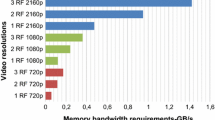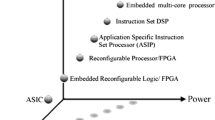Abstract
This paper describes a quarter video graphic array/common intermediate format (QVGA/CIF) resolution MPEG-4 video codec based on a low-power, general-purpose digital signal processor (DSP) (NEC μPD77210, 160 MHz, 80 mW, 1.5 V). To enhance video codec performance, the codec employs fast algorithms, including, in motion estimation, a successive similarity detection algorithm (SSDA; a fast block matching) whose decision timing for termination of block matching is optimized. Further, the use of a software direct memory access (DMA) queue reduces the wasteful DSP wait cycles that can result from massive access to external frame memories. The resulting codec executes QVGA (320 × 240 pixels) × 15 fps codec, or CIF (352 × 288 pixels) × 15 fps encoding at 384 kbps, in real time, performance levels sufficient for next-generation wireless videotelephony.
Similar content being viewed by others
References
ISO/IEC 14496-2:1999, “Information technology—Coding of audio-visual objects—Part 2: Visual,” 1999.
T. Nishikata, et al., “A 60 MHz 240 mW MPEG-4 Video-Phone LSI with 16 Mb Embeded DRAM,” ISSCC Digest of Technical Papers, 2000, pp. 230–231.
T. Hashimoto, et al., “A 90 mW MPEG4 Video Codec LSI with the Capability for Core Profile,” ISSCC Digest of Technical Papers, 2001, pp. 140–141.
J. Chaoui, K. Cyr, S. DeGregorio, J.P. Giacalone, J. Webb, and Y. Masse, “Open Multimedia Application Platform: Enabling Multimedia Applications in Third Generation Wireless Terminals Through a Combined RISC/DSP Architecture,” in Proc. of ICASSP2001, ITT-4-1, 2001.
Y. Naito and I. Kuroda, “H.263 Mobile Video Codec Based on A Low Power Consumption Digital Signal Processor,” in Proc. of ICASSP98, 1998, vol. 5, pp. 3041–3044.
Y. Naito, et al., “MPEG-4 Audio-Video Codec based on Low Power DSPs,” in Proc. of Engineering Sciences Society Conference of IEICE, A-4-8, 1999, p. 60 (in Japanese).
“µPD77210, 77213 Data Sheet,” NEC Corporation, http:// www.ic.nec.co.jp/dsp/english/products/d77210.html, 2001.
D.I. Barnea and H.F. Silverman, “A Class of Algorithm for Fast Digital Image Refistration,” IEEE Trans. Comput.,vol. 21, C-21, no. 2, 1972, pp. 179–186.
T. Moriyoshi, et al., “Real-Time Software Video Codec with a Fast Adaptive Motion Vector Search,” Journal of VLSI Signal Processing Systems for Signal, Image and Video Technology, vol. 29, no. 3, 2001, pp. 239–245.
Y. Senda, “Approximate Criteria for the MPEG-2 Motion Estimation,” IEEE Trans. Circuits Syst. Video Technol.,vol. 10, no. 3, 2000, pp. 490–497.
OMAP Architecture Team, “OMAP: Enabling Multimedia Ap-plications in Third Generation (3G) Wireless Terminals,” Texas Instruments Technical White Paper, SWPA001, http://www-s. ti.com/sc/psheets/swpa001/swpa001.pdf, Dec. 2000.
“NEC to Market Low Power Consumption, MPEG4 AV En-coder/ Decoder LSI,” NEC Corporation, http://www.nec.co.jp/ press/ja/0205/0803.html, 2002, (in Japanese))
Author information
Authors and Affiliations
Rights and permissions
About this article
Cite this article
Hatabu, A., Miyazaki, T. & Kuroda, I. QVGA/CIF Resolution MPEG-4 Video Codec Based on a Low-Power and General-Purpose DSP. The Journal of VLSI Signal Processing-Systems for Signal, Image, and Video Technology 39, 7–14 (2005). https://doi.org/10.1023/B:VLSI.0000047268.39953.60
Published:
Issue Date:
DOI: https://doi.org/10.1023/B:VLSI.0000047268.39953.60




